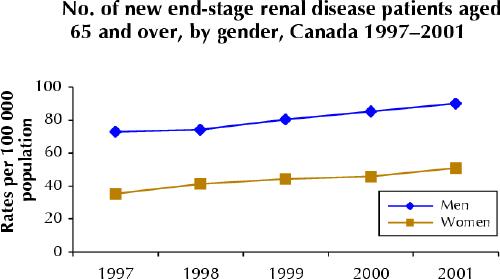The number of patients being treated for end-stage renal disease (ESRD) has risen from 13.3 per 100 000 in 1997 to 15.8 per 100 000 in 2001, an increase of 18.8% in 5 years, according to the Canadian Institute for Health Information (CIHI).
Not only did the number of ESRD patients increase, but so did their age. The number who were 65 or older went up 33% during this period. As of 2001, 55% of new patients being treated for ESRD were 65 or older. The percentage of older women in this group increased by 45%, compared to an increase of 23% among men. Men, however, still accounted for 58% of ESRD patients in 2001.
In 2001, 3% of new ESRD patients received a pre-emptive kidney transplant as their first ESRD therapy, and 75% started hemodialysis. Nearly 16 000 Canadians were receiving dialysis at the end of 2001.
The percentage of cases in which diabetes was the primary cause of ESRD increased from 29% in 1997 to 33% in 2001. Among ESRD patients aged 65 years and older, 30% were diagnosed with diabetes as their primary cause of kidney failure in 2001, up from 25% in 1997. — Tara Chauhan, Research, Policy and Planning Directorate, CMA

figure


